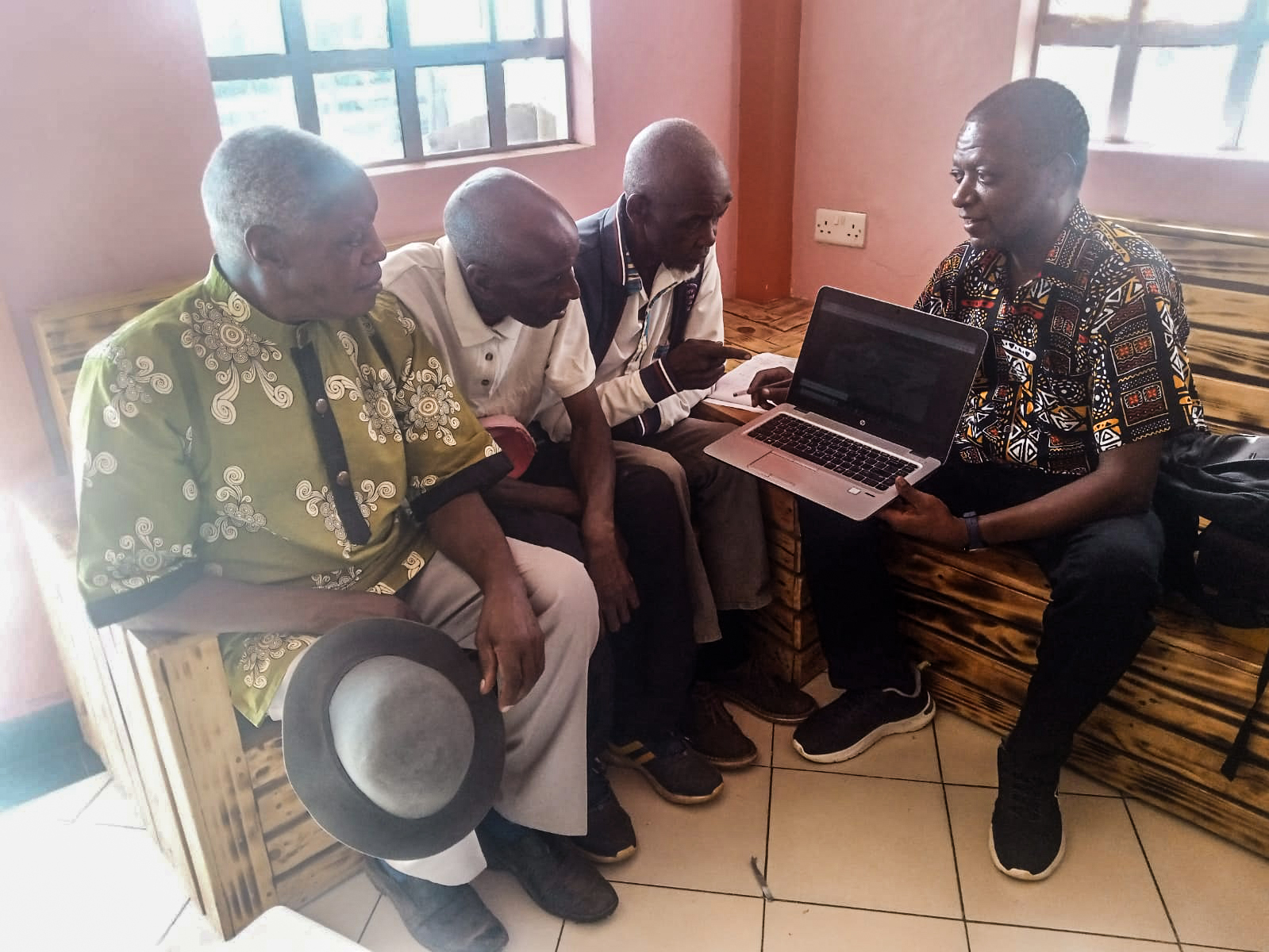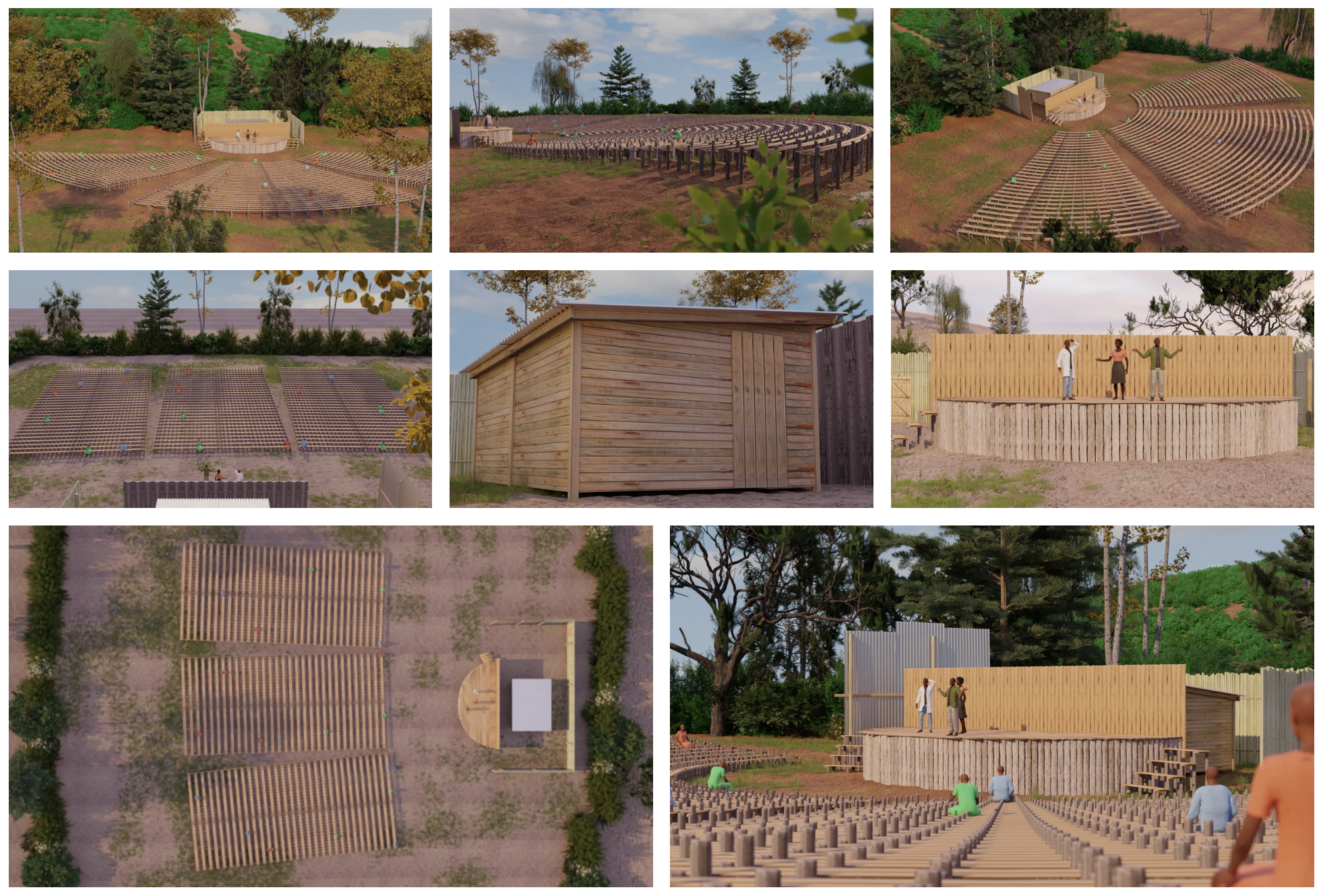Model
Kamĩrĩĩthũ Virtual Reconstruction. Video by African Digital Heritage for Kamĩrĩĩthũ Afterlives
The Kamĩrĩĩthũ Virtual Reconstruction reactivates the heritage of Kamĩrĩĩthũ by creating a three-dimensional model of the original open-air theatre. In collaboration with African Digital Heritage, we developed a collaborative process for the virtual reconstruction of the vast wooden structure that once stood in Kamĩrĩĩthũ and hosted thousands of people. This process is rooted in the spirit of Kamĩrĩĩthũ theatre itself, and in alignment with the collaborative ethics of Kamĩrĩĩthũ Afterlives and the values of African Digital Heritage. The process relied heavily on consultation with the original performers and primary oral and visual history research.

David Njaramba Kaguura, Githiga Mwaura, Mbothu Wachira, and Makau Kitata, in a call with Kenny Cupers discussing the draft model on 20 January 2023.

The final 3D model (Images by African Digital Heritage for Kamĩrĩĩthũ Afterlives)
Process and sources for the virtual reconstruction
To date, there are very few photographs of the original open-air theatre and its surrounding environment available, and no technical plans of the original structure exist. This lack of visual evidence compounds the state-mandated demolition and erasure of the Kamĩrĩĩthũ theatre in 1982.
The team employed a mix of approaches and sources to build the virtual reconstruction. The principal researchers Kenny Cupers and Makau Kitata shared previously unpublished photographs and oral testimonies which they had gathered from their research. After an initial study of secondary and primary visual sources, Mutanu Kyany’a, Muthoni Mwangi, and Michael Khakame created a draft model and formulated a set of questions about the stage itself, the changing room, the space and the materials used in the construction for the actors. Kenny and Makau brought these questions and images of the draft model to the original performers to get their detailed feedback, which allowed the team from African Digital Heritage to tweak the initial draft.
During the meeting, the performers suggested that the theatre space was inspired by the theatre space in the Education building of the University of Nairobi, called ED II. Makau and Mutanu then visited this space, referred to as “ED II,” in order to get a better estimation of the Kamĩrĩĩthũ Auditorium layout and dimensions.
After revising the model, a second meeting with the Kamĩrĩĩthũ performers and the whole project team followed. The actors provided for final comments and approval. We all subsequently visited the polytechnic, in order to virtually imagine the built structure on site and ascertain its former placement on the site. This allowed us to arrive at the most accurate model of the theatre.
At the Kamĩrĩĩthũ polytechnic, Geoffrey Mbothu Wachira and Michael Khakame from African Digital Heritage
discuss how the open-air theatre was laid out and where it once stood, on 25 March 2023 (Video: Cupers)
The vivid and emotional response of the original performers during these meetings conveys the power of virtual reconstruction projects such as this one. We plan to mobilize this virtual reconstruction in our project to reimagine performance arts on the site.
︎︎
Consultation by the following original performers of Kamĩrĩĩthũ theatre:
David Njaramba Kaguura, Geoffrey Mbothu Wachira, Wangari wa Hinga,
James Githiga Mwaura, Lucy Wangui Ng'ang’a.
Virtual Reconstruction Team:
Kenny Cupers, Kamĩrĩĩthũ Afterlives Principal Investigator
Makau Kitata, Kamĩrĩĩthũ Afterlives Principal Investigator
Mutanu Kyany’a, African Digital Heritage Coordinator
Muthoni Mwangi, Curator / Researcher
Michael Khakame, 3D Artist
To get an in-depth look into the Kamirithu Theatre Virtual Reconstruction process, check out African Digital Heritage’s reporting here.